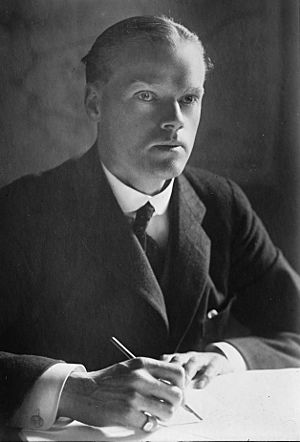George Sutherland-Leveson-Gower, 5th Duke of Sutherland facts for kids
Quick facts for kids
The Duke of Sutherland
|
|
|---|---|
 |
|
| Under-Secretary of State for Air | |
| In office 31 October 1922 – 22 January 1924 |
|
| Monarch | George V |
| Prime Minister | Bonar Law Stanley Baldwin |
| Preceded by | The Lord Gorell |
| Succeeded by | William Leach |
| Paymaster General | |
| In office 28 January 1925 – 2 December 1928 |
|
| Monarch | George V |
| Prime Minister | Stanley Baldwin |
| Preceded by | Vacant |
| Succeeded by | The Earl of Onslow |
| Under-Secretary of State for War | |
| In office 2 December 1928 – 4 June 1929 |
|
| Monarch | George V |
| Prime Minister | Stanley Baldwin |
| Preceded by | The Earl of Onslow |
| Succeeded by | The Earl De La Warr |
| Personal details | |
| Born | 29 August 1888 Cliveden, Buckinghamshire |
| Died | 1 February 1963 (aged 74) |
| Nationality | British |
| Political party | Conservative |
| Spouses |
Lady Eileen Butler
(m. 1912; died 1943)Clare Josephine O'Brian
(m. 1944) |
| Parents | Cromartie Sutherland-Leveson-Gower, 4th Duke of Sutherland Lady Millicent St Clair-Erskine |
George Granville Sutherland-Leveson-Gower (born August 29, 1888 – died February 1, 1963) was the 5th Duke of Sutherland. He was an important British figure who held various roles in government and was a big supporter of the film industry. He was known by different titles before becoming Duke, like Earl Gower and Marquess of Stafford.
The Duke was a member of the Conservative Party. He served in the government during the 1920s. Later, he became the Lord Steward of the Household, a senior position in the royal household. He is especially remembered for his support of British movies. The Sutherland Trophy, an award given by the British Film Institute, is named after him.
Contents
Early Life and Education
George Sutherland was born in 1888 at Cliveden House in Buckinghamshire, England. He was the oldest son of the 4th Duke of Sutherland, Cromartie Sutherland-Leveson-Gower. His mother was Lady Millicent St Clair-Erskine.
He attended two well-known schools in England. First, he went to Summer Fields School in Oxford. After that, he studied at Eton College, a famous boarding school.
Military Service and World War I
George Sutherland had a career in both the army and the navy. From 1909 to 1910, he was a lieutenant in the Royal Scots Greys, a cavalry regiment. He then became a captain in the 5th battalion of the Seaforth Highlanders, a Scottish infantry regiment, from 1910 to 1912. He was also an Honorary Colonel for this battalion starting in 1914.
During the First World War, he joined the Royal Naval Reserve. He rose to the rank of commander. In 1914, he was in charge of a ship called HMT Catania. He also worked with the British Military Mission in Belgium from 1914 to 1915. From 1915 to 1917, he commanded a group of motor boats that sailed between Egypt and the Adriatic Sea. For his service, he received an award called the Order of the Crown of Italy.
Political Career and Public Service
In 1913, George Sutherland became the Duke of Sutherland after his father passed away. This meant he took his place in the House of Lords, which is part of the British Parliament. In the same year, he was appointed Lord-Lieutenant of Sutherland. This was an important local role, and he held it until 1944.
He also served as the Lord High Commissioner to the General Assembly of the Church of Scotland in 1921. This role involved representing the King at the Church of Scotland's main meeting.
Government Roles in the 1920s
The Duke of Sutherland held several government positions in the 1920s. He worked for the Conservative governments led by Bonar Law and Stanley Baldwin.
- From 1922 to 1924, he was the Under-Secretary of State for Air. This role involved helping to manage the country's air force.
- From 1925 to 1928, he served as Paymaster General. This position was responsible for government payments.
- From 1928 to 1929, he was the Under-Secretary of State for War. In this role, he helped oversee the army.
In 1929, he was made a Knight of the Thistle. This is a very high honor in Scotland. In 1936, he joined the Privy Council, a group of advisors to the King. He was also appointed Lord Steward of the Household, a senior position in the royal household, which he held until 1937. In 1937, he carried the orb during the coronation ceremony of King George VI.
Support for the Film Industry
The Duke of Sutherland was a strong supporter of the British film industry. He was the first Chairman of the British Film Institute (BFI). He held this position from 1933 to 1936. Even after that, he remained a patron of the BFI until he passed away.
To honor his contributions, the BFI created the Sutherland Trophy in 1958. This award is given to the creator of "the most original and imaginative film" shown at the National Film Theatre each year.
Family Life
George Sutherland married Lady Eileen Gwladys Butler on April 11, 1912. She passed away in 1943. The following year, on July 1, 1944, he married Clare Josephine O'Brian.
The Duke of Sutherland died in 1963 when he was 74 years old. He did not have any children. After his death, his titles were split up. The Earldom of Sutherland and Lordship of Strathnaver went to his niece, Elizabeth Sutherland, 24th Countess of Sutherland. His other titles went to a distant relative, the Earl of Ellesmere.

